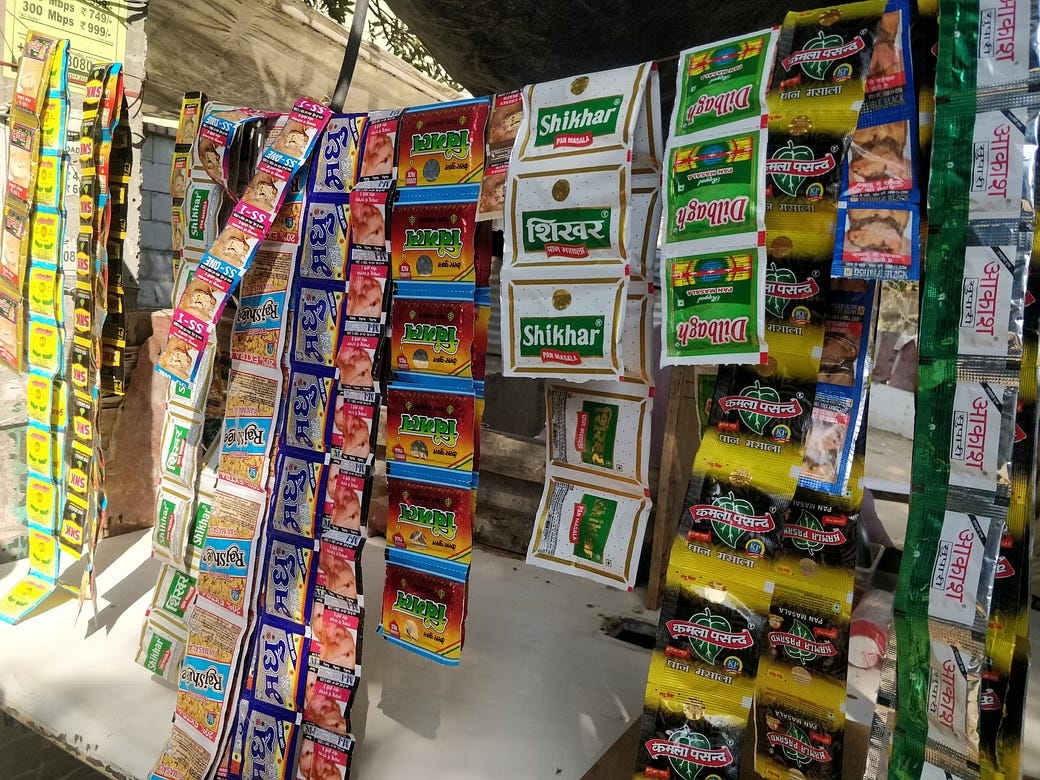The Puzzling Connection
The past week has indeed been challenging, losing in the Cricket World Cup finals after maintaining an undefeated record was particularly distressing. I thought the defeat in 2019 had made me numb, but I still managed to relive the pain once more. Kudos to me for that 🥲
Adding a touch of bitterness to this experience was watching TV, a rare occurrence for me these days, during a World Cup final and seeing some of my childhood heroes - Virender Sehwag, Kapil Dev, Sunil Gavaskar, SRK, and Akshay Kumar—converging to endorse pan masala and gutkha after every over.
This sparked a simple yet intriguing question in my mind: How does this industry generate enough revenue to attract such colossal stars together in a single endorsement?
The Birth of the Pan Masala Industry: A 'Brown Revolution' Tale
The story begins in a small Gujarat village in 1925 when Sri Mansukh Lal Mahadev Bhai Kothari initiated his journey by selling hair oil shop-to-shop. He later expanded to buying and selling cigarettes from Kolkata to Kanpur. In 1973, with an investment of Rs. 12000, he launched the brand ‘PAN PARAG’ as a pan masala product, marking the inception of a 'Brown Revolution.'
It is important to note that Paan has a deep history and culture worldwide and is the most common mouth freshener in India and many places in the world. The significance of Paan is evident from the numerous citations from ancient literature, particularly the Indian scriptures.
For example, a well-prepared Paan is still regarded as an excellent mouth freshener and mild energizer, routinely served on social, cultural, and religious occasions such as marriages, pujas (religious ceremonies), festivals, and after-meal entertainers.
Sri Mansukhbhai gave birth to the pan masala industry, and now over 200 brands of pan masala are available in India.
Unveiling the Ingredients: Gutka vs. Pan Masala
Understanding the distinctions between gutka (tobacco) and pan masala is crucial. While pan masala may not contain tobacco, it often includes areca nut (also known as betel nut), a known carcinogen.
Even though pan masala, without tobacco, seems less harmful, the presence of areca nut raises health concerns. The products these industries sell, and more importantly, the customers hooked onto them, are rarely devoid of health risks.
The World Health Organization presents chilling statistics, stating that tobacco-related cancers account for 10 crore deaths, a figure projected to soar to a staggering 100 crores in the 21st century.
Market Evaluation
In 2021, the Indian pan masala market had a value of INR 41,821 Crore. It is estimated that the market would grow at a CAGR of 3.88% from 2022 to 2027, reaching INR 53,081.5 Crore.
To put its scale into perspective, it's vital to recognize that this figure surpasses other significant sectors like the chocolate and biscuit where the markets are valued at Rs. 16,000 crores and Rs. 37,000 crores respectively.
Unit Economics
According to reports, a mere fraction - less than 40% of the revenue is dedicated to the complete manufacturing process of this product. In this economic dance, the profit margin emerges, revealing itself to be around 60%.
Now, let's focus on the role played by the pricing strategy for sachets in shaping the industry's dynamics. The affordability of these small packages is a masterstroke, contributing to a low customer acquisition cost.
Well that covers CAC but what about retention? Turns out when you sell an addiction, you don't have to fight for monthly recurring revenue!
But, Who are the Customers?
When an industry is making so much money, it makes you wonder - Who's behind the success of the pan masala industry, especially when it seems like nobody you know is a consumer?
The customers of the pan masala industry are predominantly found in rural India. This demographic predominantly consists of males aged 25 to 54, residing in areas characterized by a low wealth index.
The advantage of starting the Pan Masala business is that every Indian knows its drawbacks but still 80% of Indians love consuming it. If we talk about it, every street corner has at least one shop selling Pan Masala. It is more visible than the food shops. This information is enough to understand that people like it more than food in the market that is why the number of tobacco shops is also increasing.
Bypassing Bans
So, how does the industry manage to flourish despite the undeniable health risks associated with its products?
The answer lies in its ingenious marketing strategies.
Most pan masala brands don’t advertise their products directly, and run commercials of elaichi or cardamom instead, which are free from tobacco, nicotine, areca nut or any other addictive substances.
India has an advertising ban in place that prevents the direct advertising of tobacco products, just the same as liquor. But then you see the ad of Vimal Elaichi (it’s hundred percent Tobacco-free), Rajnigandha Silver Pearls, McDowell’s Club Soda (remember number one yaari hai song?), and Seagram’s Imperial Blue Music CDs.
Though when you go to the market, you wouldn’t even find half of these products. What sells is the ‘real’ thing — The Pan Masala, Gutka, and Liquor.
Why the Industry Persists: Unraveling the Complexity Behind the Non-Ban
While it's evident that the pan masala industry has contributed to the rise in health issues, the reasons for its non-ban are somewhat straightforward.
To begin with, it's crucial to recognize that people's consumption and addiction to these products are not solely determined by their legal status. If there's a demand, there will always be a supply, irrespective of legal restrictions.
First of all, let's understand that people don't consume or get addicted to these things based on whether it's legal or not. If you want to consume it, you'll always find someone happy to sell it.
If the government bans gutka or pan masala, there are a few underlying threats:
Banning gutka/pan masala leads to higher addiction to the same: This may sound counter intuitive, but it's true. Banning Gutka/pan masala would mean that illegal sellers can sell these at a higher margin of profits, further increasing the supply of the same. Let's take the example of Marijuana criminalization in the USA. In the 1950s, usage of Marijuana became illegal and a clear spike in the consumption was observed. It was made legal back in 1970s and the growth rate of consumption became 0.
If you make Gutka/pan masala illegal, people might turn to other more potent drugs: This is extremely dangerous as the side effects of Gutka and pan masala are insignificant compared to opium and other stuffs.
One of the least impactful controversial reason why it's not banned is the tax benefit for the government and political support.
What you are missing: A public relations masterstroke
As the cash flows in, roping in high-profile celebrities seems doable. However, assuming the role of a 'responsible citizen,' one can't help but question the behavior of these ‘idols’. This is where the plot thickens.
In November 2021, Amitabh Bachchan sent a legal notice to the pan masala brand Kamla Pasand that he was endorsing and terminated his contract with pan masala and returned the money received for the promotion after he was heavily trolled on social media for abandoning his social duties.
While he annulled his contract, the ads featuring him and Ranveer Singh have continued on television unabated (apart from thousands of hoardings and posters which continue to be on display in the market).
This is a public relations masterstroke, where despite an annulled contract, advertising continues, the brand gains and the celebrity takes the cake of being a responsible citizen.
Well this is for today, till then ✌🏻(reversed 😛)
Hiring 📢
SDE hiring at multiple levels at Kodo: https://bit.ly/47toGYp
Generalist hiring at Meyagegifting:
https://twitter.com/amanmehta26/status/1727984588566208899
Product Management Intern / Freelance Collaborator (GenAI, NLP) at FutureSmart AI: https://bit.ly/47BaD36
Product Marketing Manager & Product Analyst at Tap Invest: https://bit.ly/3GeWpss
If you are hiring and want us to send out your job opening in the next newsletter, you can reach out to us by dropping a text here or by replying to this mail.
Builder’s Cohort 4🔨
In case you have missed the announcement, Crework’s upcoming Builder's Cohort kicks off in December, featuring a larger community of builders, offering non-stop support and guidance.
If you've been harboring the dream of creating your own project, side hustle, or side project, now is the perfect opportunity to turn that dream into reality!
Go grab your seat, apply here.







